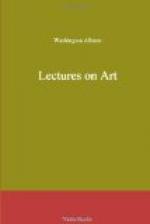But there is scarcely a subject on which mankind are wider at variance, than on the beauty of their own species,—some preferring this, and others that, particular conformation; which can only be accounted for on the supposition of some predominant expression, either moral, intellectual, or sensual, with which they are in sympathy, or else the reverse. While some will task their memory, and resort to the schools, for their supposed infallible rules;—forgetting, meanwhile, that ultimate tribunal to which their canon must itself appeal, the ever-living principle which first evolved its truth, and which now, as then, is not to be reasoned about, but felt. It need not be added how fruitful of blunders is this mechanical ground.
Now we venture to assert that no mistake was ever made, even in a single glance, concerning any natural object, not disfigured by human caprice, or which the eye had not been trained to look at through some conventional medium. Under this latter circumstance, there are doubtless many things in nature which affect men very differently; and more especially such as, from their familiar nearness, have come under the influence of opinion, and been incrusted, as it were, by the successive deposits of many generations. But of the vast and various multitude of objects which have thus been forced from their original state, there is perhaps no one which has undergone so many and such strange disfigurements as the human form; or in relation to which our “ideas,” as we are pleased to call them, but in truth our opinions, have been so fluctuating. If an Idea, indeed, had any thing to do with Fashion, we should call many things monstrous to which custom has reconciled us. Let us suppose a case, by way of illustration. A gentleman and lady, from one of our fashionable cities, are making a tour on the borders of some of our new settlements in the West. They are standing on the edge of a forest, perhaps admiring the grandeur




